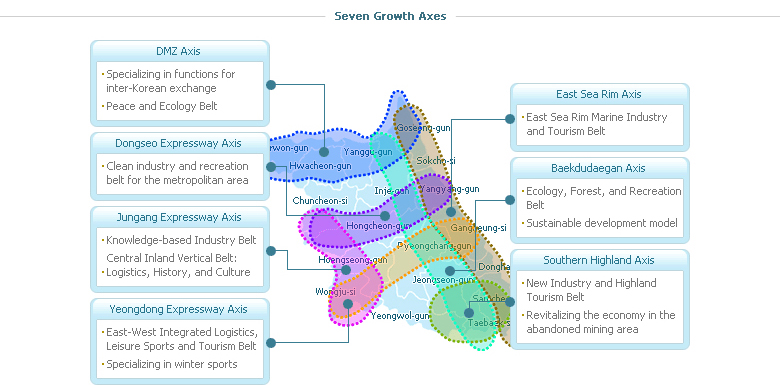content start

Background of the Plan
- Considering the geopolitical and geographical conditions of Gangwon State, long-term strategies would be pointless without discussing the changes in the relationship between the two Koreas and the situations in the East Sea Rim area and Northeast Asia.
- The Gangwon 7+6 Plan is a full-scale plan to meet the changes in domestic and foreign situations, and promote the balanced development of local peculiarities around seven growth axes (divided by the traffic network and resource potentials) and six life zones.
Strategy for Seven Growth Axes
- Secure and agglomerate economies that concentrate the resources into a strategic stronghold to effectively distribute resources and specialize in local peculiarities.
- Create new opportunities for growth based on local specificity by promoting interaction between the cities and local areas.
- Promote functional strongholds that play the act as arteries across Gangwon State based on the traffic network and local peculiarities. (Serve as a strategic axis that responds to the development of the metropolitan area, the administrative complex city, and the new cities.)
Description of Seven Growth Axes
One-Day business & recreation belt for the metropolitan area around Jungang Expressway Axis between Chuncheon and Wonju
- Linking the east axis extending to Russia, Japan, and North Korea, with the west axis extending to the metropolitan area, Jeolla-do, North Korea, and China, and cooperating with the administrative complex city.
- Developing a resort area covering all-season leisure sports, winter sports, industry, academics, and residence around Gangwon State, including Chorwon, Chuncheon, Hongcheon, Hoengseong and Wonju, on the Yeongdong Expressway - the 3rd east-west axis of the National Intermodal Transportation Network.
- Enhancing the logistics functions of the east and west axes, expanding the internationally recognized leisure sports infrastructure, i.e., the Winter Sports Valley, and building an innovative city that serves as an industrial stronghold.
- Integrating the resort with winter sports, constructing a suburban style and pension housing complex, and linking the East Sea Rim axis with the present metropolitan area and the future metropolitan area after the construction of the administrative complex city.
Highland tourism and resort belt around the abandoned mining area
- Linking the administrative complex city and the east axis extending to Russia, North Korea, and Japan.
- Developing the resort in the abandoned mines area and the natural environment around the 4th east-west axis of the National Intermodal Transportation Network that links Pyeongtaek, Eumseong, Yeongwol, and Samcheok.
- Fostering industries related to resort life, including high-tech agriculture, in order to secure a stronghold in southern Gangwon State.
- Promoting the new/renewable energy industry and preserving/restoring the environment and local life.
- Establishing a domestic casino as part of the promotional plan for the abandoned mining area and expanding the express traffic network linking Asan, Jecheon, Samcheok, and Donghae in preparation for a new administrative capital to be constructed in Chungcheong-do.
East Sea Rim logistics and tourism belt along the east coast
- erving as a gate that links Korea with Russia, North Korea, and Japan along the east coast.
- Developing the marine and tourism industries along the 7th north-south axis of the National Intermodal Transportation Network and promoting a new marine industry integrating marine resources with the high-tech industry.
- Expanding the north-south traffic networks, including airports and harbors, and enhancing logistics and tourism in the East Sea Rim.
- Fully utilizing Yangyang international Airport, revitalizing the Geumgangsan (Mt.) Tour, developing the Seoraksan-Geumgansan International Free Tourism Zone and the Donghae Free Trade Zone, offering tourists culture and tourism experiences, and promoting the “Making the East Coast Beautiful Project.”
Korean peace and ecology belt around the borderlands
- A district rich in ecological resources that links the west axis with the east axis in the very middle of unified Korea.
- Focusing the functions of inter-Korean exchanges and promoting peace and ecology around the 1st east-west axis of the National Intermodal Transportation Network.
- Building an inter-Korean logistics base and enhancing the symbolic value and local peculiarities to foster the area as a world-class peace and ecology area.
- Constructing a tentatively named "Korean Peace Town" that will house a peace/culture plaza, a peace/ecological park, a place for inter-Korean exchanges, a DMZ museum, and the construction of a median line for the country. It will also include and promote strategic projects, such as the exchange of water resources.
Clean industry and recreation belt around the Dongseo Expressway Axis between Chuncheon and Yangyang
- A center for Gangwon State's administration effectively linking the metropolitan area with the east axis.
- Developing extensive water resources, mountain resources, and clean industries, and enhancing the clean and recreational function of the metropolitan area to attract the relocation of public institutions that are presently settled in the metropolitan area.
- Building a brand city with an environmentally-friendly lake around Chuncheon, an adventure and leisure sports city around Inje, and a logistics and exchange stronghold around Yangyang.
Ecology, forest and recreation belt around Baekdudaegan
- Utilizing the ecological potential of Baekdudaegan, a so-called geographical barrier to connecting the eastern and western parts of the country in Gangwon State.
- Developing the area as a stronghold for nature and ecology tourism.
- Activating green tourism, creating a new concept where mountain villages integrate agriculture and fisheries with tourism, and promoting projects that preserve the environment.

최근 업데이트 2023-10-30

